Can drones appeal to the masses?
- Published
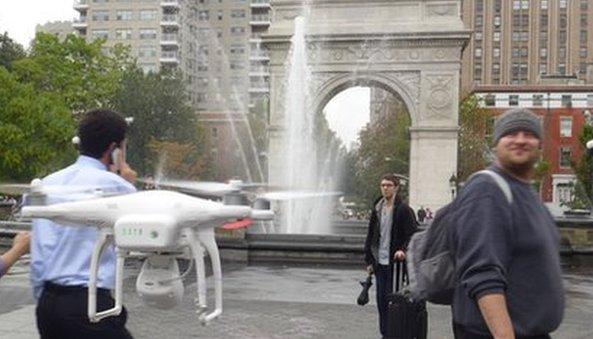
A passerby in New York's Washington Square Park inspects the Phantom 2 drone
The latest generation of camera-equipped drones offers the chance to take the kinds of photos once only available to helicopter pilots. The BBC's Kim Gittleson asks if the drones of the future will be panorama picture takers, not predators.
On a recent windy autumn day in New York City, I tagged along with Colin Guinn, the chief innovation officer at DJI, to Washington Square Park in lower Manhattan.
DJI, explained Mr Guinn, is a firm that develops and engineers small unmanned aerial vehicles that are meant to carry cameras. Drones, basically, that carry cameras instead of guns.
Stopping just in front of the park's iconic arch, he placed a black suitcase on a bench and pulled out what appeared to be a very elaborate toy helicopter.
White and about the size of a large textbook, I was informed this was actually the Phantom 2 Vision - DJI's latest drone.
It has four detachable propellers to help keep the camera, which hangs from its middle, stable when it's up in the air.
After giving me some basic instructions on how to use the remote control - two joysticks with a smartphone acting as a real-time viewer - off I went.
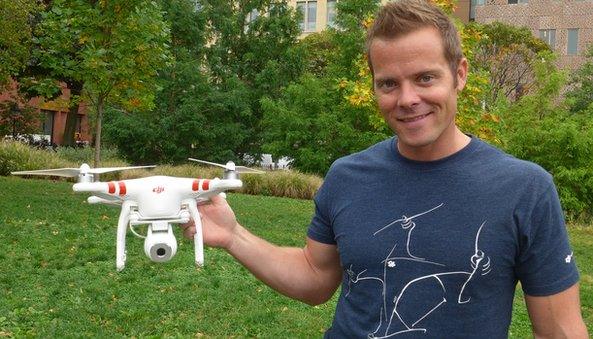
Colin Guinn holds the Phantom 2 Vision, which is controlled by a user on the ground with a remote control
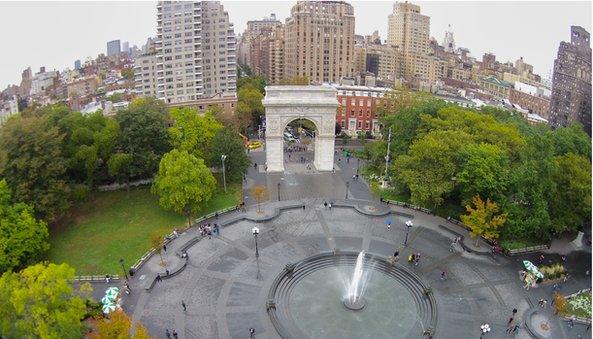
The drone can fly up to 1,000 feet away from its owner using a special wireless router and has a battery life of around 25 minutes

Mr Guinn says: "If you're out flying around and looking down at all these buildings and all of sudden you look up and you're like 'where's my Phantom?' You can tap a radar button to find it."
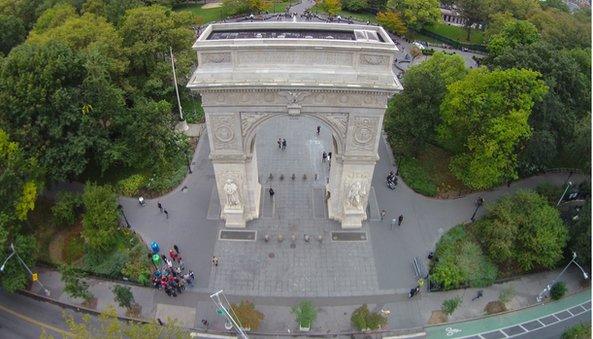
US law says that hobbyist drone pilots can operate as long as they stay under 400 feet and the drone weighs less than 55lb.
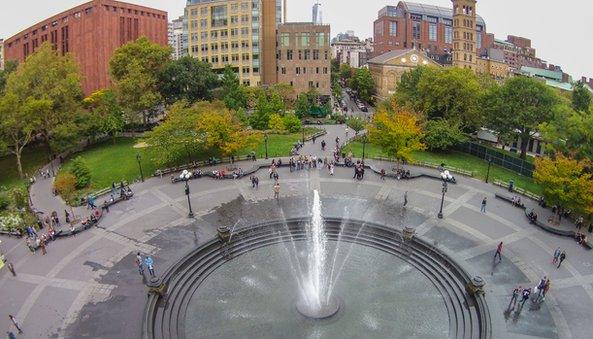
Using the compass app on the iPhone, one can manoeuvre the Phantom to look at the pilot - helping it to safety return to its home location.
Suddenly, it was like seeing through the eyes of a bird. The app on the smartphone beamed back breathtaking images using the wireless router attached to the Phantom's belly.
Jaded New Yorkers stopped and formed a small crowd as the Phantom buzzed overhead, crowding around to look at the screen.
When one man asked where he could get one, he reacted with surprise when Mr Guinn answered: "Just go up the street to B&H", referring to the US high street electronics superstore.
The man's surprise turned to shock when he heard how much they cost: "$1,199 each."
'Tip of the iceberg'
Long used in American military operations overseas, the technology of drones - or unmanned aerial vehicles (UAVs) as the industry calls them - has come home, and at a price significantly less than the tens of thousands of dollars spent on army operations.
Obviously, they are also serving a more benign use.
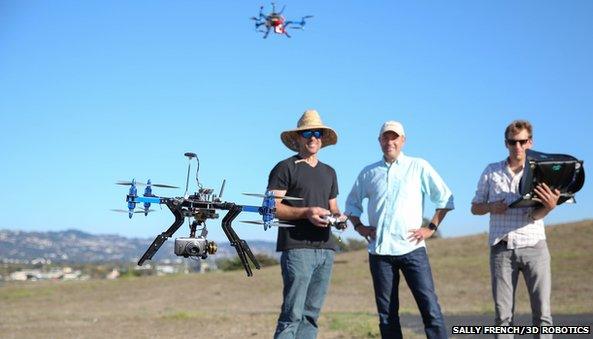
Chris Anderson (centre) is the head of 3D Robotics, the biggest player in the hobbyist consumer drone industry
Hobbyists have been making their own hand-crafted versions, using cobbled together bits of metal and wires for almost a decade.
But now new, cheaper camera technology has attracted a slew of start-ups aiming to capitalise on consumer interest in aerial photos.
A recent industry study, external by research firm the Teal Group found that the worldwide commercial drone market could top $89bn (£55bn) in the next 10 years.
"We're kind of in that early adopters stage right now and even the tip of this iceberg is very big," says Mr Guinn.
"People are not recognising that as cameras get better, being able to make really spectacular videos is something a lot of people want to do," says Chris Anderson, who quit his job as head of Wired magazine, external to start a company called 3D Robotics after the enthusiastic response he saw for drones within the do-it-yourself community.
Since its founding in 2009, he says 3D Robotics has increased sales by 100% each year to become a multi-million dollar firm. It recently raised $30m in funding.
The trick, he says, is making technology that is both affordable and easy to use, likening drone technology to videogames.
"Once you have that level of simplicity using devices that we all own and are comfortable with then you could sell in the millions," he says.
The 'peeping Tom' problem
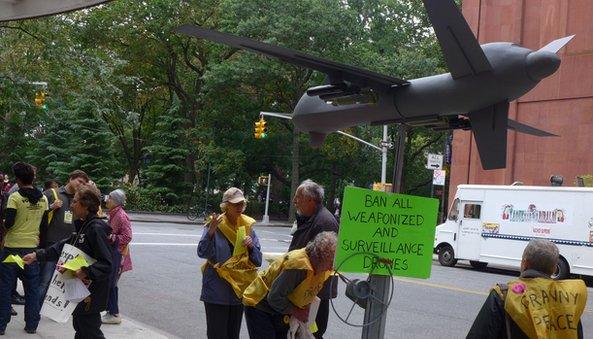
A group of protestors outside a drone conference in New York expressed fear over drone surveillance capabilities
However, an appealing vision of the future to some can be an Orwellian nightmare to others.
Jay Stanley, a senior policy analyst at the American Civil Liberties Union, says while his organisation has been wary of government use of drones, in private hands, the issue is more complicated.
"The courts have pretty much found that you have a constitutional right to take pictures of things in public places [and] I think we would extend that to drones," he says.
He adds that so-called "peeping Tom" laws prohibiting neighbourly spying would almost certainly apply to inappropriate drone use as well.
"If you put a ladder up to your neighbour's second-story bedroom window and look in, I don't think that's any different than using a drone to do the same thing - I think the law will cover both equally," he says.
Crowded airspace
Mr Guinn of DJI says that it's not privacy concerns he's most worried about, but US regulations regarding unmanned aerial vehicles.
"The big concern is just safely integrating [drones] into the national airspace," he says.
For many drone manufacturers, this is the crucial issue.
Right now, guidelines put out by the Federal Aviation Authority (FAA) ban the use of drones in American airspace for commercial purposes - i.e. for anything other than the sort of hobbyist flying that I did with Mr Guinn in Washington Square Park.
Commercial applications include selling drones to police for law enforcement and to farmers to help them monitor crops.
The service ban exists because according to the FAA, the US has the most congested airspace in the world.
It has said that it plans to release new rules by 2015 that could open up US airspace to drones. The agency estimates that 10,000 new drones could be in flight in the first few years after the ban is lifted.
No more fear of flying
But at the moment, it's the hobbyist firms like DJI, Parrot and 3D Robotics that are growing the fastest.
Both DJI and 3D Robotics are coming out with a slew of new models in time for the Christmas period.
DJI's Phantom 2 Vision will be sold for $1,199, and 3D Robotics says it plans to sell its new Iris model for around $800.
"I'd love it to be likened to the DSLR revolution," says Mr Guinn, referring to high-end cameras.
"When they started shooting video, that changed the face of independent filmmaking. We want to do the same with aerials."
- Published31 October 2013
- Published29 October 2013
- Published31 January 2012